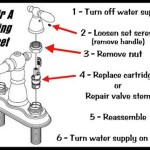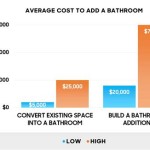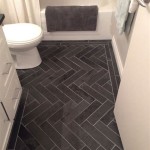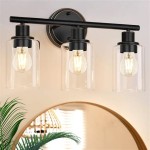Cost to Replace Bathroom Subfloor: A Comprehensive Guide
The bathroom subfloor, the unsung hero beneath your tile or vinyl, provides a stable and level base for your bathroom flooring. However, constant exposure to moisture, leaks, and general wear and tear can compromise its integrity, leading to rot, mold, and structural instability. Consequently, bathroom subfloor replacement becomes a necessity to prevent further damage and maintain the safety and value of your home. Understanding the factors influencing the cost of this replacement is crucial for budgetary planning and project execution.
The cost to replace a bathroom subfloor is not a fixed figure. It fluctuates based on numerous variables, including the size of the bathroom, the type of subfloor material used, the extent of the damage, and the labor costs in your geographical area. This article provides a comprehensive overview of these factors and their impact on the overall cost, offering a detailed guide for homeowners contemplating this essential home improvement project.
Key Factors Influencing the Cost
Several key factors contribute to the overall cost of replacing a bathroom subfloor. These factors need to be considered to develop a realistic budget and understanding of the project's complexity.
Size of the Bathroom
The size of the bathroom directly correlates with the amount of subfloor material required. A larger bathroom naturally necessitates more plywood or OSB (oriented strand board) to cover the area. Material costs are typically calculated per sheet, and the total square footage of the bathroom will determine the number of sheets needed. Labor costs are also affected by the size, as a larger area requires more time and effort to remove the old subfloor and install the new one. Consider, for example, a small half-bath versus a large master bathroom; the difference in cost will be significant due to the varying surface areas involved.
Type of Subfloor Material
The choice of subfloor material significantly affects the overall cost. The most common materials used are plywood and OSB. Plywood is generally considered a higher-quality material and is more resistant to moisture and warping, making it a preferred choice for bathrooms. However, it is also more expensive than OSB. OSB is a cheaper alternative, made from compressed wood strands and adhesives, but it is more susceptible to water damage. Using treated plywood, which offers enhanced moisture resistance, will further increase the cost compared to standard plywood or OSB. The selection should align with the bathroom's moisture exposure and the homeowner's budget considerations.
Extent of the Damage
The extent of the damage to the existing subfloor is a critical factor. Minor isolated areas of rot or water damage might be repairable with patching, which is significantly less expensive than a full replacement. However, widespread rot, mold, or structural weakening necessitates a complete subfloor replacement. The removal of severely damaged sections can also be more labor-intensive, potentially increasing labor costs. Furthermore, if the damage has extended to the floor joists beneath the subfloor, these also require repair or replacement, adding substantially to the overall expense. A thorough inspection by a qualified contractor is essential to accurately assess the extent of the damage and determine the appropriate course of action.
Labor Costs
Labor costs constitute a significant portion of the total cost of subfloor replacement. These costs can vary widely depending on the contractor's experience, their hourly rate, and the geographic location. More experienced contractors typically charge higher rates but may also offer better quality workmanship and faster completion times. Geographic location plays a role due to variations in the cost of living and the prevailing wage rates in different areas. Complex installations, such as those involving intricate layouts or the need for specialized tools, can also increase labor costs. Obtain multiple quotes from licensed and insured contractors to compare prices and ensure you are getting a fair rate for the work.
In addition to the core labor costs, consider potential add-on expenses. These could include charges for demolition and disposal of the old subfloor, leveling the floor joists, or addressing any plumbing or electrical issues discovered during the process. Clear communication with the contractor regarding the scope of work and potential additional costs is vital to avoid unexpected expenses.
Type of Flooring Being Installed
The type of flooring intended to be installed over the subfloor can influence the choice of subfloor material and installation methods, thereby affecting the overall cost. For instance, ceramic tile or stone flooring requires a more rigid and stable subfloor than vinyl or laminate flooring. This might necessitate using a thicker plywood or adding an additional layer of underlayment to ensure adequate support and prevent cracking. The added material and labor will increase the total expense. Discussing the flooring options with the contractor during the planning phase is crucial to selecting the appropriate subfloor and ensuring its compatibility with the desired flooring.
Accessibility and Complexity of the Job
The ease of access to the bathroom and the complexity of the job site can impact labor costs. Bathrooms located on upper floors or in areas with limited access may require more time and effort to transport materials and equipment, leading to higher labor charges. Similarly, bathrooms with complex layouts, such as those with multiple fixtures or unusual angles, can require more intricate cutting and fitting of the subfloor material, increasing the time and skill required for installation. Obstacles such as pipes, wiring, and other utilities can also add to the complexity and cost of the project.
Estimating Material Costs
Calculating the material costs involves accurately determining the square footage of the bathroom and the price of the chosen subfloor material. Plywood and OSB are typically sold in 4x8 foot sheets (32 square feet). Measure the length and width of the bathroom in feet and multiply these dimensions to calculate the total square footage. Divide the total square footage by 32 to determine the number of sheets needed, rounding up to the nearest whole number to account for waste. Contact local lumberyards or home improvement stores to obtain pricing for plywood and OSB sheets, allowing for variations in grade and thickness. Add an estimated 10-15% to the material cost to account for cutting waste and unforeseen circumstances.
In addition to the subfloor material, other materials may be required, such as screws, construction adhesive, shims for leveling, and moisture-resistant sealant. These miscellaneous materials can add to the overall cost and should be factored into the budget. A detailed materials list should be prepared in consultation with the contractor to ensure all necessary items are accounted for.
Understanding Labor Cost Estimates
Labor cost estimates can vary significantly between contractors. Obtain at least three quotes from different contractors to compare pricing and services. Ensure that the quotes are detailed and clearly outline the scope of work, including demolition and disposal of the old subfloor, installation of the new subfloor, and any necessary leveling or repairs. Ask the contractors about their experience with subfloor replacement and their qualifications and insurance coverage. Check online reviews and ask for references to assess the contractor's reputation and quality of workmanship.
Be wary of estimates that are significantly lower than others, as this could indicate a lack of experience or the use of substandard materials. A reputable contractor will provide a detailed and transparent estimate that includes all costs associated with the project. Do not hesitate to ask questions and clarify any uncertainties before signing a contract. A written contract should be in place that outlines the scope of work, payment schedule, and warranty information.
Potential Additional Costs
During the subfloor replacement process, unforeseen issues may arise that can lead to additional costs. These potential pitfalls should be considered when budgeting for the project.
Floor Joist Repair or Replacement
If the floor joists beneath the subfloor are damaged due to rot, mold, or insect infestation, they will need to be repaired or replaced. This can significantly increase the overall cost of the project, as it requires specialized skills and additional materials. A structural engineer may be needed to assess the extent of the damage and determine the appropriate repair方案. The cost of floor joist repair or replacement can range from a few hundred to several thousand dollars, depending on the severity of the damage.
Plumbing and Electrical Issues
During the removal of the old subfloor, plumbing and electrical issues may be discovered that need to be addressed. Leaking pipes, damaged wiring, or code violations may require immediate attention to ensure the safety and functionality of the bathroom. These repairs can add to the overall cost of the project and may require the services of a licensed plumber or electrician. It is prudent to have a contingency fund in place to cover unexpected repairs.
Mold Remediation
If mold is present on the subfloor or surrounding areas, mold remediation will be necessary before installing the new subfloor. Mold remediation involves removing the mold and treating the affected areas to prevent future growth. The cost of mold remediation can vary depending on the extent of the infestation and the size of the area affected. It is essential to address mold issues promptly to protect the health of the occupants and prevent further damage to the property.
Permits
Depending on local building codes, a permit may be required for subfloor replacement. Check with the local building department to determine if a permit is necessary and what the associated fees are. Failing to obtain a permit can result in fines and delays in the project. The permit process may involve submitting plans and inspections to ensure that the work complies with building codes.
Cost-Saving Strategies
While subfloor replacement is a necessary expense when damage is present, there are strategies to potentially reduce the overall cost.
Obtain multiple quotes from different contractors to compare pricing and services. Providing contractors with detailed information about the project and asking specific questions about their experience and approach can help ensure that you are receiving accurate and competitive bids. Consider negotiating the price with the contractors to see if they are willing to offer any discounts or incentives.
Consider performing some of the demolition work yourself, such as removing the existing flooring and subfloor. This can save on labor costs, but it is essential to exercise caution and follow safety protocols to avoid injury. Ensure that you have the necessary tools and equipment and that you dispose of the debris properly. Be aware that some contractors may be hesitant to work on a project where the demolition has been done by the homeowner, as it can affect their liability coverage.
Choosing less expensive subfloor materials, such as OSB instead of plywood, can reduce material costs. However, consider the long-term implications of using a lower-quality material, such as reduced moisture resistance and durability. Weigh the cost savings against the potential for future problems and repairs. It may be more cost-effective in the long run to invest in a higher-quality material that will last longer and require less maintenance.
Be proactive in addressing any leaks or moisture issues in the bathroom to prevent future subfloor damage. Repairing leaky faucets, showerheads, and toilets can help prevent water from seeping into the subfloor and causing rot and mold. Ensuring proper ventilation in the bathroom can also help reduce moisture levels and prevent damage. Regularly inspecting the subfloor for signs of water damage can allow for early detection and repair, preventing the need for a full replacement.

Subfloor Replacement Cost S Fixr

Subfloor Replacement Cost S Fixr

Subfloor Replacement Cost S Fixr

Floor Repair Cost Sagging Fixr

Free Advice How Much Does A Subfloor Repair Cost

How Much Does It Cost To Replace A Subfloor 2025

2025 Subfloor Replacement Cost Factors And Installation Guide

Free Advice How Much Does A Subfloor Repair Cost

2025 Subfloor Replacement Cost Factors And Installation Guide

Bathroom Subfloor Repair
See Also







